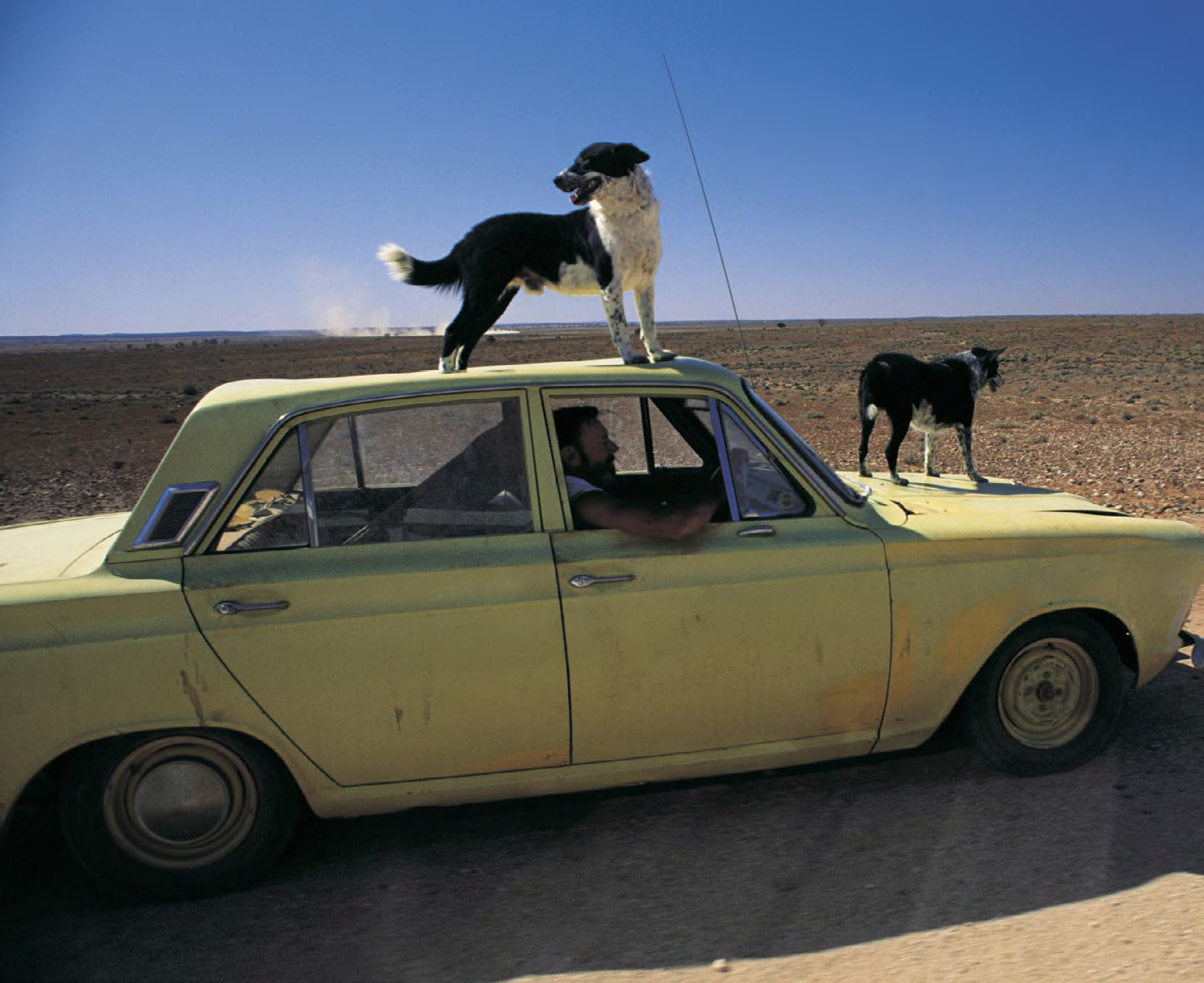
Dogs are best kept in the vehicle when driving – but they need plenty of time outside the car to avoid becoming fidgety. Tourism NSW/Dorothea Schmid
Rex, Red, Buster and Buddy – as well as Sasha, Missy and Jess – love nothing more than a holiday. Certainly, they seem to like it more than a boarding kennel for a week or two.
But it’s not always as simple as throwing a blanket on the passenger seat and heading down the highway. Travelling with a four-legged friend can add real companionship, but it also requires some planning.
These things include thinking about whether your pet is used to travelling in a vehicle. If not, take it for a test drive and see how it copes. Some relatively calm pets turn back to animals once they’re trapped inside a moving vehicle. It is important that you invest in restraints, or – especially in the case of felines – transport crates. Also, consider where the animal will be sitting while you’re on the road, and ensure there is enough fresh air, as well as heating or cooling.
Then you need to make sure all their ID is up to date – some holiday parks insist pets be registered, for example, as well as having proof of current vaccinations, worming and even flea prevention. Make sure your animal has a collar with current identity tags, including both home and mobile numbers in case it goes wandering – there is a greater chance of your animal getting lost in unfamiliar surroundings than at home.
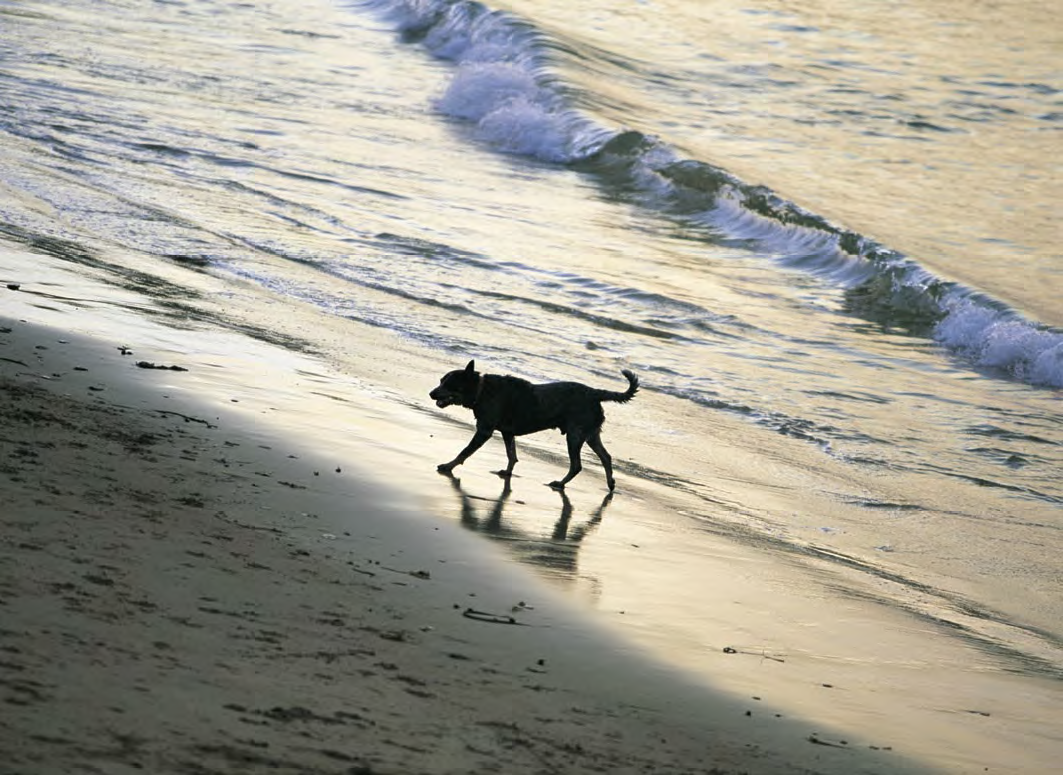
Check before you go whether dogs are allowed on the beach. Sometimes they’re restricted to certain hours – or they might be banned altogether. Tourism NSW
Be prepared to make plenty of stops to allow them to stretch their legs, have a drink and do their business. The more stops, the better. Never leave your animal alone in the car: they can die of heatstroke in a matter of minutes. Also, dogs and cats with white fur are at risk of sunburn, so make sure they can escape the elements, particularly on beach holidays.
If you’re staying at a beach, be sure to check that the beach allows dogs on the sand. Some beaches are completely petfree or have certain pet-friendly hours.
Of course, you’ll have to take the usual things your pet needs on a daily basis, but you may also want to consider putting together a pet first aid kit. These are similar to human first aid kits, but in pet sizes and can be bought at some pet shops or online at the RSPCA superstore (www.worldforpets.com.au). A pressure bandage is a must to restrict the blood flow in the case of snake-bite – the same as with humans. However, dogs can be more likely to be bitten as instead of running away, they might confront the snake.
You can also ask your vet about the area where you are travelling, to see if there are any additional health risks for your dog, and choose travelling locations where there is a vet close at hand in case of emergencies.
Although you might be tempted to change your pet’s diet on holidays, it’s important not to drastically alter your animal’s routine because this could lead to an upset stomach or digestive problems.

Your best friends need lots of water on holidays – they can dehydrate quickly, especially if they’re busy. Tourism NSW
Accommodation
One vital thing to consider is whether pets are accepted in the places you intend to stay. You can do a quick check of The Wanderer’s Mate guide – there is a little icon of a dog on holiday parks that are pet friendly. Usually this is ‘conditional’ which could mean any of a variety of things, from relying on the manager’s discretion to a simple restriction such as keeping the dog on a leash, or perhaps a long list of requirements.
Some holiday parks pride themselves on being pet friendly and even promote themselves as such. As an example, we’ll look at the Tathra Beach Family Park near Bega on the New South Wales south coast (1300 527 010).
They advertise a pet friendly policy where your best friend is welcome. They believe dogs are part of the extended family and therefore should be welcomed to the Park. However, they have a list of requirements that include ensuring that all dogs are registered and desexed. Pets are welcome all year on site (and in one pet friendly cabin) except for the four-day Easter weekend and the Christmas school holidays.
Guide dogs are always welcome any time of year. That of course applies not just to this Park, but to any public place as there is a legal right for a person using a harnessed guide dog to enter all public places, including restaurants.
The Tathra Beach Family Park also requires that dogs be kept on a leash whenever it is outside the campervan or cabin. Disturbances such as barking are to be kept to an absolute minimum to ensure that other guests are not inconvenienced.
And of course, you have to clean up after your dog.
They don’t allow dogs in the accommodation (except the pet friendly cabin), the amenities, pool, playground or laundry. Again, guide dogs are excepted.
Dogs are often loved as much as family members. But they are animals, so sometimes they act completely irresponsibly and cause strife and even damage. (Some family members might do that, too.)
The dog owner is always responsible for any damage to property and – heaven forbid – any personal injuries. It is also common in agreements that the park be indemnified from liability if there is any damage caused by your animal.
If you’re staying in a cabin and dogs are allowed, they would tend to be restricted from certain areas – such as the carpeted areas and beds – with the risk of incurring an additional cleaning fee.
Also, check out the Holidaying with Dogs website to find Five Paw Awarded accommodation.
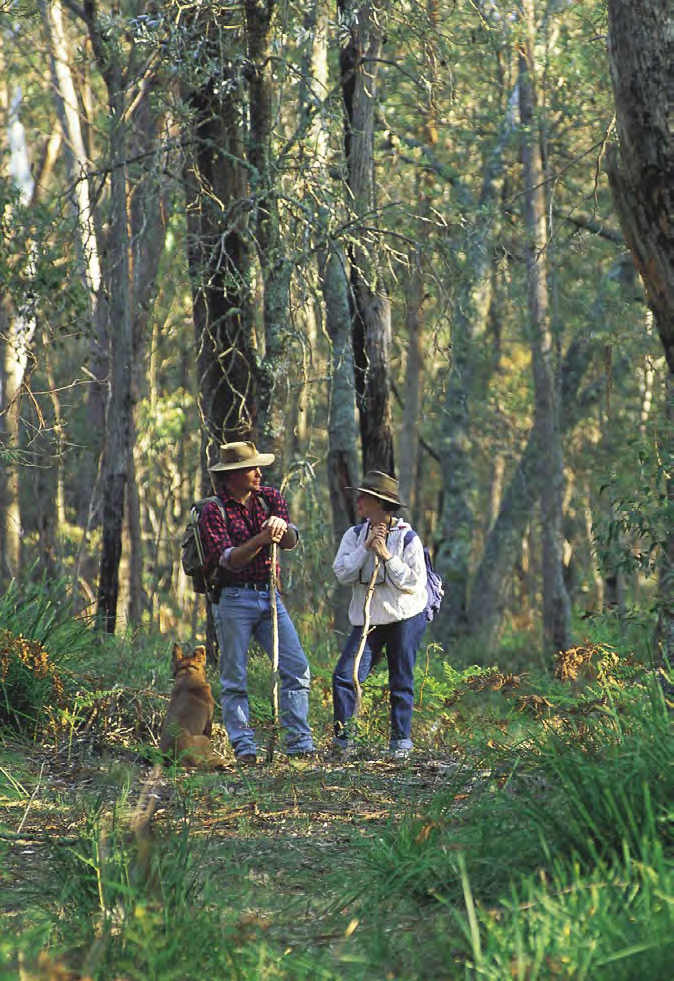
Most national parks have restrictions of dogs, with many – but not all – banning them altogether. Check before you go. Tourism NSW

Dogs love a release from their normal environment. Tourism NSW
National parks
The rules for national parks vary from state to state, and even region to region and park to park. It’s best to check with each park you intend to visit.
But as a general rules, pets – and dogs in particular – are not greeted enthusiastically to say the least. There is a very simple reason for that. Dogs are predators and tend to be enthusiastic carnivores.
National parks and reserves are refuges for native animals. That is one of their main reasons for existence.
Although family pets might be sweet and relatively docile at home, they can quickly click into their natural mode and want to chase and kill animals. This might not be true of all dogs, but there is certainly an underlying tendency that makes it prudent for national parks to generally restrict dogs.
Another reason is that dogs (and cats) may run off, become lost and go feral. Then, if they don’t die first, they can fine-tune their inert hunting skills and become killing machines.
Dogs and other domestic pets (other than trained assistance animals such as guide dogs) are generally refused entry into national parks, state conservation areas, nature reserves, historic sites and Aboriginal areas.
As well as the reasons mentioned above, dogs also leave a scent. This predator-scent can be so overpowering for small native animals that they will flee the habitat, sometimes leaving their young unprotected. As well as the obvious problem for the native animals, it also leads to less enjoyment for visitors to the parks because they can’t enjoy the presence of the native animals anymore.
Also, dog waste can carry diseases that might be harmful to wildlife.
However, there are some regional parks where dogs can be walked – some leashed, and some unleashed including beaches. Of course, you’re still expected to clean up after your dog.
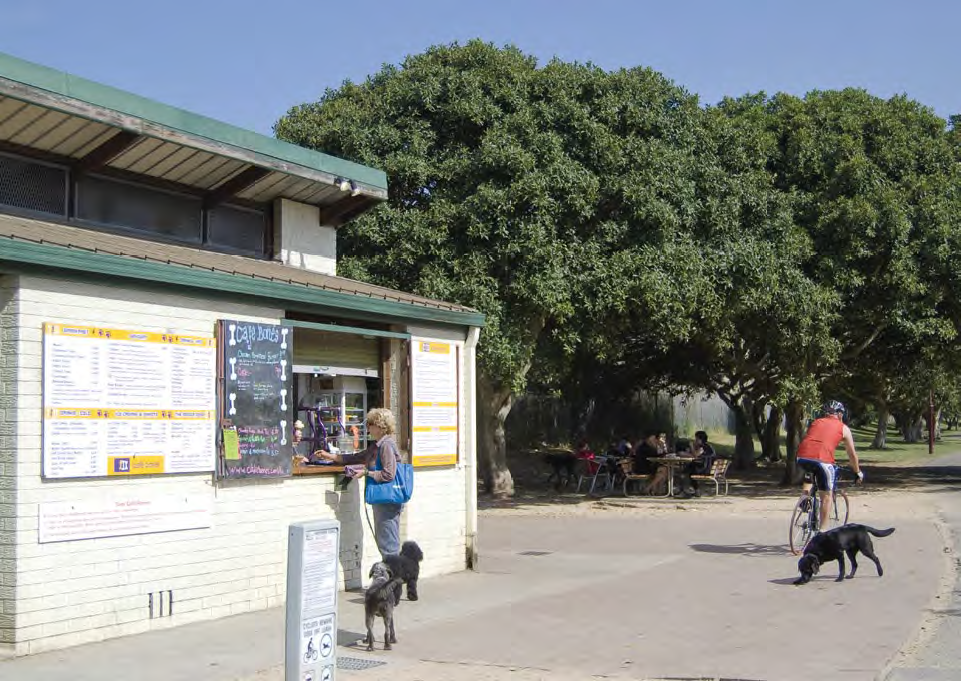
The Cafe Bones in Sydney’s Haberfield, famous for its Puppichino made from foamy broth. Tourism NSW
Camping with dogs
The Australian Explorer website (www.australianexplorer.com/pets) has a list of suggestions for people camping with dogs, starting with the very good advice to take full responsibility for the animal’s behaviour. Other ideas include:
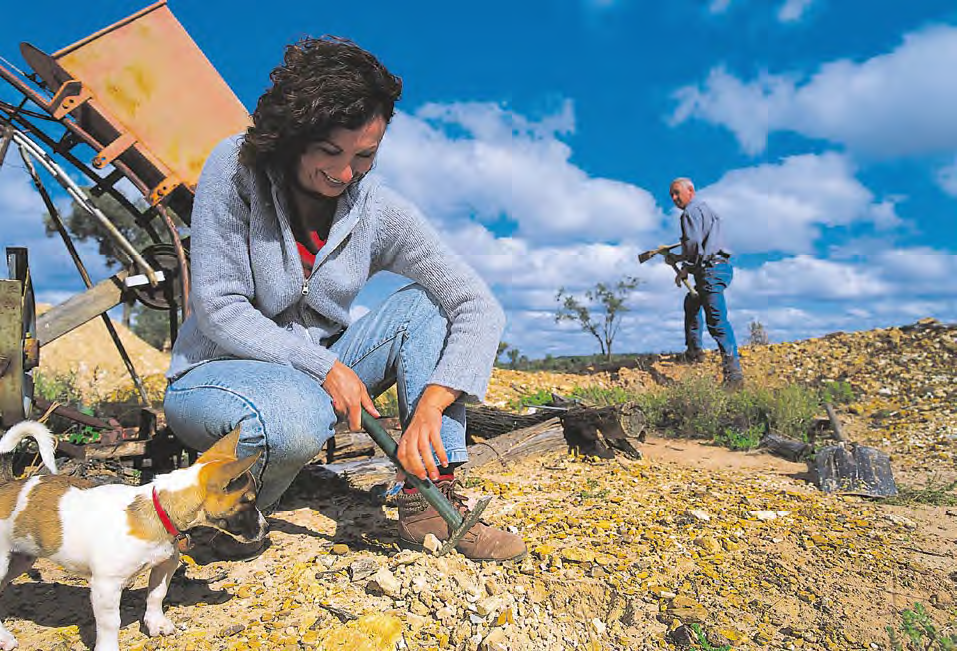
Dogs are inquisitive, which means they can really enjoy new experiences, but you need to keep an eye on them. Travel Queensland
Queensland holiday parks
Queensland has many caravan parks and holiday parks that are pet-friendly. Here are several: Gold Coast Holiday Park, Helensvale, has dog-friendly accommodation including cabins and powered or unpowered sites for campervans. With 32 acres of space, this site is a social hub for your pet. Dogs are required to be on leads and accompanied at all times as koalas and kangaroos also share this property. Local dog sitting and dog grooming can be arranged on request. (www.goldcoastholidaypark.com.au)
Boyne Island Caravan Park, Gladstone, has 12 acres of parkland on the banks of the Boyne River. This spot is located conveniently just 20 minutes outside Gladstone City, in an ideal fishing location. Pets are allowed, provided they are on leads and accompanied at all times. With bushland surrounds and fishing to partake in, you and your pet can enjoy the natural environment. (www.caravanqld.com.au)
Big4 Airlie Cove Resort and Van Park, Airlie Beach, is set on 28 acres of tropical land, and is conveniently located just past Airlie Beach, the gateway to the Whitsunday Islands. Cabin-style, campervan and camping sites are available. Pets are welcome, provided management has first cleared their stay. (www.airliecove.com.au)
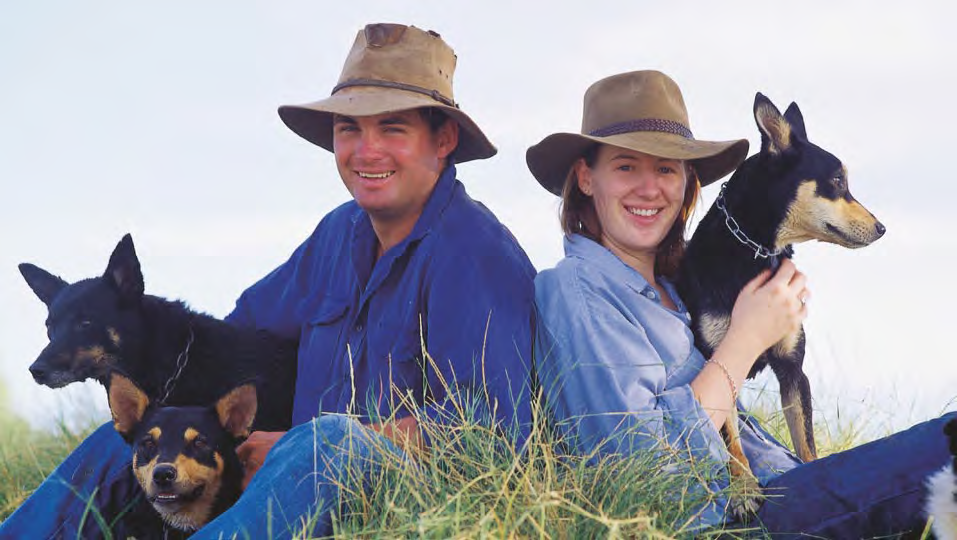
Two dogs can also keep each other company while travelling. Travel Queensland
Big4 Rollingstone Beach Caravan Resort, Rollingstone, overlooks Palm and Havana Islands. It has luxury villas, ocean view cabins, powered sites for motorhomes and camping. Set in natural bushland close to waterfalls and with private beach access, there are plenty of things to do with your pet. (www.rollingstone-beach-caravan-resort.qld.big4.com.au)

We all know dogs love a long walk. Tourism Victoria
Taking a walk in Tassie
Tasmania has wide expanses of natural beauty and untouched land, providing a relaxed atmosphere for a camping holiday, and many camping destinations encourage visitors to bring along their canine friends.

Tasmania is home to many dog-friendly camping sites. Tourism Tasmania
All airlines and the Spirit of Tasmania ships that connect mainland Australia with Tasmania take dogs in well-ventilated and supervised kennels. Once your furry friends are on dry land, you can let them off the leash at one of the many dog-friendly beaches or exercise areas, or enjoy the outdoors in selected on-leash forests and reserves, all of which can be found at www.discovertasmania.com.au
Some of the dog-friendly holiday park options are included below.
Discovery Holiday Park Devonport is set on the banks of the beautiful Mersey River. Here you can bring your dog and relax on the waterfront. (03 6427 8418, www.discoveryholidayparks.com.au.)
Longford Riverside Side Caravan Park is nestled on the banks of the Macquarie River, close to Launceston, the regional centre for Northern Tasmania. A central location for walking trails, wineries, fishing and more, this caravan park welcomes pets on leads to its variety of camping options. (03 6391 1470, www. longfordriversidecaravanpark.com.)
At Seven Mile Beach Cabin and Caravan Park, visitors can explore Tasmania’s south and immerse themselves in the beauty of the surrounding area. The Park prides itself on welcoming pets. It is situated alongside the beach and offers the full spectrum of camping accommodation for families and their pets. (03 6248 6469, www.comfycabins.com.au)
There are also a large number of petfriendly accommodation options available in Victoria. On the Great Ocean Road there is Blue Johanna Cottages – romantic self-contained cottages and in-house suites with uninterrupted views of the ocean, rock shelves and sandy beaches. Nearby are the Glenaire Cottages with amazing views, 100 acres of bird filled forest and private walking trails near the Great Ocean Road. Glenaire Cottages offers easy access to Johanna Beach and an easy drive to the Twelve Apostles.

Taking your pet with you can provide companionship on your holiday. Tourism Victoria
In the High Country is Allambie Cottages in Bright where the back decking area allows easy access to the rail trail and views of kangaroo families on the hills. Also in Bright is Tyntynder Cottages, surrounded by an acre of magnificent, private, mature gardens. They have fully self contained, completely renovated cottages. They won the Five Paw Awards in 2005, 2006, 2007, 2008, 2009 and 2010! 
Don’t forget to feed and water your little four legged friends. Tourism Victoria
On the Goldfields is the Hollow Log Estate – Joint Victorian Winner of the 2010 Five Paw dog-friendly accommodation award. The Estate offers a choice of two superb cottages set on 27 acres in a beautiful country setting, overlooking the Wombat State Forest. It is only a short drive from the attractions of Daylesford and the Hepburn Springs spa country.
On the Mornington Peninsula is Blue Moon Cottages, where stylish beachside cottages are hidden just 250 metres from Rye Beach. Couples, families and their pets are welcome.
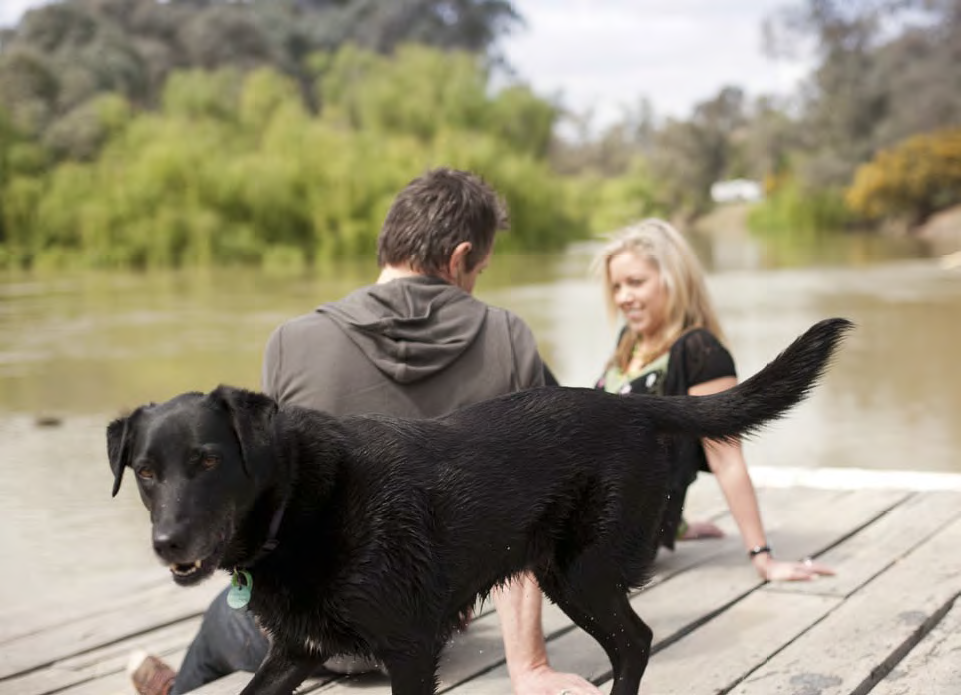
Let’s have a swim. Tourism Victoria
Category: Features
Written: Fri 01 Feb 2013
Printed: February, 2013
Published By:
For more information:
Travel NSW: www.visitnsw.com.au or 13 20 77
The Australian Explorer: www.australianexplorer.com/pets
Tourism Queensland: www.queenslandholidays.com.au or 13 88 33
Tourism Tasmania: www.discovertasmania.com or 1300 733 258
Dogzonline: www.dogzonline.com.au
Pet Friendly: www.petfriendly.com.au
Tourism Victoria: www.visitvictoria.com or 13 28 42
Holidaying with Dogs: www.holidayingwithdogs.com.au